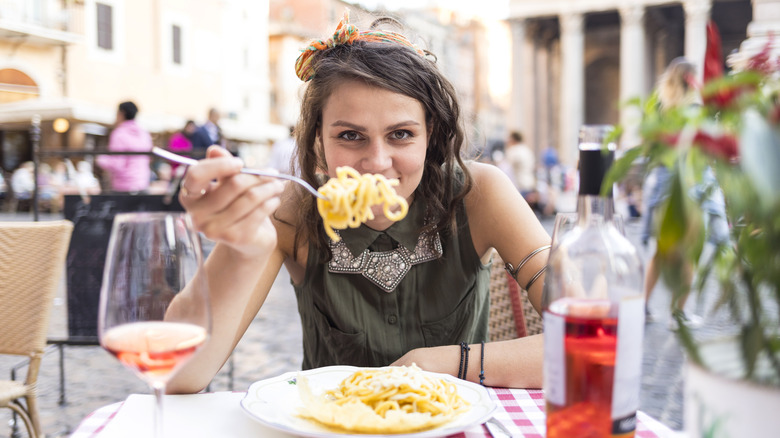Known for its exquisite cuisine, Italy is a haven for foodies. One thing you should know is that dining in Italy can be quite different from eating at Italian restaurants in other countries. Many dishes you might expect to find on menus in Italy simply don’t exist there. In addition, dining customs can differ from what you’re used to at home.
Italian food is widespread around the globe thanks to the vast Italian diaspora, a spread of people that took place from the 1800s to the 1920s. During that time, millions of Italians left their homeland, seeking better opportunities abroad. While the newcomers brought many of their culinary traditions, they also adapted to the ingredients available in their new homes and created new dishes and food traditions. For example, Italian-American food is now considered a distinct cuisine in its own right.
If you’re planning a trip to Italy, there are some things you should think twice about ordering at a restaurant because you might get some strange looks. These tips can help you avoid eating like a tourist in Italy so that you can have a more authentic dining experience. They can also prevent you from making some embarrassing dining etiquette mistakes.
Tap water

You may come across numerous public drinking fountains on the streets of Italy, but it’s not common practice to drink tap water at a restaurant. Patrons are typically given a choice between still or sparkling water (“acqua naturale” and “acqua frizzante” respectively). As one traveler on a Rick Steves’ Europe forum thread commented, “Italians virtually never drink tap water, esp. [sic] at restaurants. You can ask for acqua al rubinetto (tap water) if you want, but be prepared for some serious stinkeye because it truly is considered a faux pas.”
The reason you won’t often find free water at restaurants in Italy is not necessarily because the water is unsafe or because the restaurants are trying to make more sales (although that may be the case in some spots). It’s often simply that the tap water in many parts of Italy contains minerals that make it taste unappealing. With that in mind, you could be better off paying a few Euros for bottled water. Then again, if you are in one of the best cities in Italy for wine tasting, who needs water anyway?
Butter or olive oil for your bread

One thing that surprises many foreign diners in Italy is that when bread is served with a meal, it usually doesn’t come with condiments like butter, olive oil, or balsamic vinegar. You may think your server has forgotten the condiments, only to find them baffled when you request dips or spreads for your bread. Contrary to the norm at Italian restaurants outside of Italy, it’s not common to serve bread with anything other than your meal at a restaurant.
There are several reasons Italians don’t serve condiments with bread. First, butter, olive oil, and balsamic vinegar can be expensive, so many Italians consider it a waste to use them on bread. In addition, as one Reddit user from Italy said, “You don’t want to cover the flavor of the bread with the very strong flavor of olive oil.” According to food writer Elizabeth Minchilli, bread is meant to be eaten with your meal rather than in addition to it, and Italians typically eat bread as an accompaniment to soup or antipasti. It can also be used to help push food onto the fork or to sop up extra sauce.
Spaghetti and meatballs
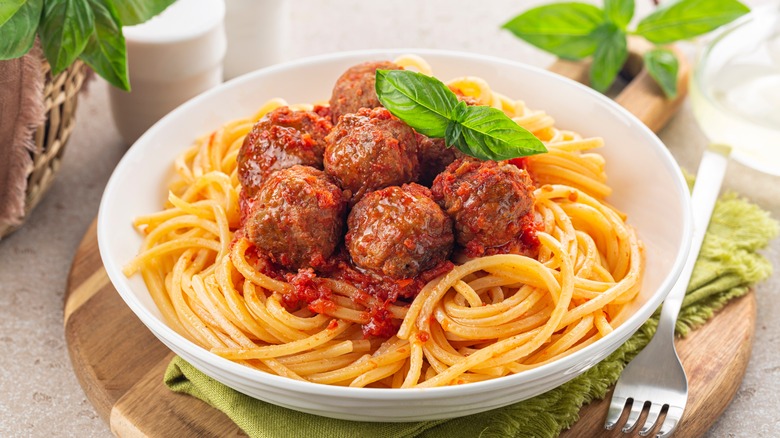
OlgaBombologna/Shutterstock
For many people, spaghetti and meatballs is the quintessential Italian dish. It’s a staple at many “red sauce” restaurants and a favorite with home cooks for its simple yet delicious Italian flavors. There’s only one catch — it’s not actually Italian. You may find it offered at some restaurants in Italy, but they will likely be spots that cater to tourists. The combo of spaghetti, meatballs, and marinara sauce was created by Italian immigrants in America.
According to the Auguste Escoffier School of Culinary Arts, meatballs are called “polpettes” in Italy, and they are typically smaller than the American versions and eaten on their own without the sauce. Recipes vary across the country, with some versions containing vegetables, fish, or pork. When Italians moved to the United States in the late 19th and early 20th centuries, many found that ground beef was relatively affordable, so they adapted their polpette recipes accordingly. Canned tomatoes and dried pasta were also readily available and cheap. By combining the three, they had an easy-to-make, hearty meal reminiscent of home.
A spoon for your spaghetti
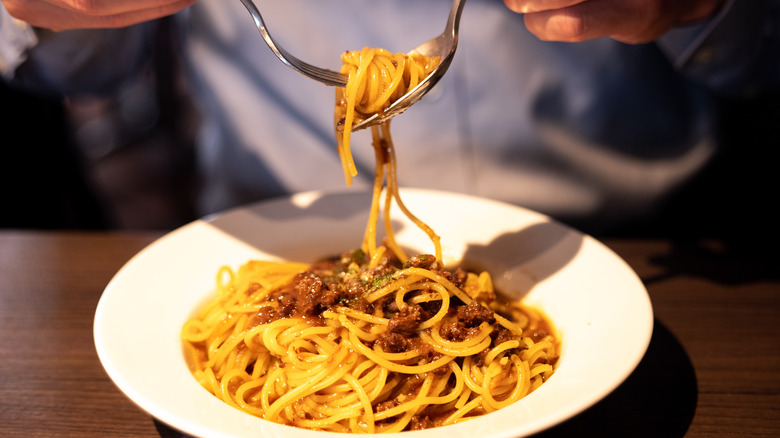
Kayoko Hayashi/Getty Images
If you grew up eating pasta at home, you might have been taught that it’s polite to use a spoon for long noodles because it helps gather up the noodles neatly and prevents you from making a saucy mess. However, you might get some side eye if you request a spoon for your spaghetti in Italy. And don’t even think of cutting your pasta into pieces with a knife — the correct way to eat pasta is to use your fork and your fork alone to twirl up your pasta.
A Reddit thread on eating spaghetti with a spoon inspired strong opinions. One user commented, “In my experience, it’s viewed as something only children who haven’t learnt to twirl them properly would use. For an adult without hand mobility problems it’s bad manners, like eating with your elbows on the table or slurping soup.” In terms of using a knife to cut pasta, one Quora user said, “It is highly unusual, not impolite. Maybe you could compare it with having sushi with a fork. Or a hot dog with fork and knife.”
Chicken parmigiana
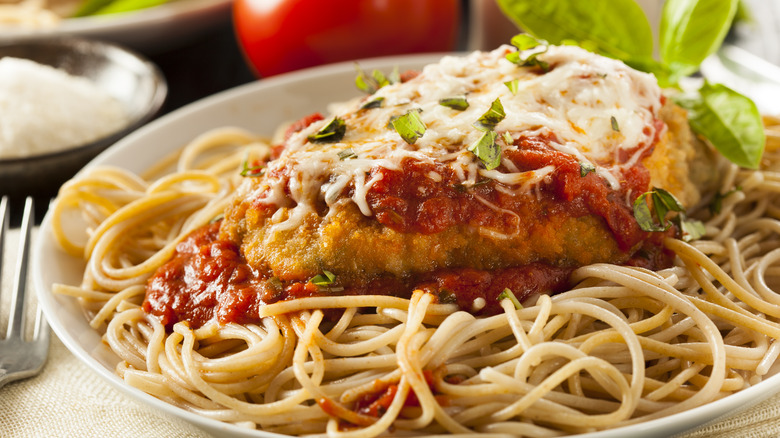
Bhofack2/Getty Images
It’s easy to see why chicken parmigiana is such a craveable dish. The combination of crispy breaded chicken smothered in tangy tomato sauce and melted cheese is the perfect comfort food dish. However, if you get a craving when you’re in Italy, you may struggle to find it on any restaurant menu. Although it has its roots in Italian cuisine, chicken parmesan is another dish created by Italians who immigrated to America.
According to Paesana, chicken parmigiana is based on a dish called melanzane alla parmigiana, aka eggplant parmigiana. The dish consists of slices of fried eggplant layered with tomato sauce and cheese and baked until piping hot. It’s a rustic dish that developed from what all people had on hand in their gardens and kitchens. When Italians immigrated to the United States, they found that protein like chicken was more widely available and affordable than in Italy, while eggplant was not so easy to find. Substitutions were made, and chicken parmesan was born.
Italian dressing
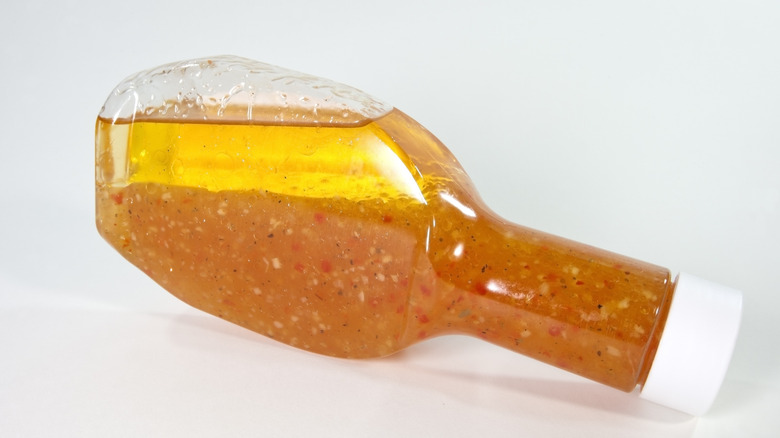
Joe_potato/Getty Images
With ingredients like olive oil, lemon juice, vinegar, and oregano, Italian dressing contains many Mediterranean flavors. Yet, despite its name, this zippy dressing was created in the United States. La Cucina Italiana reports that two restaurant owners created the zesty dressing as we know it today. Philip Sollomi, the owner of Wish-Bone restaurant in Kansas City, claimed that his dressing was based on his Sicilian mother’s recipe, while Ken Hanna of Ken’s Steak House in Framingham, Massachusetts, claimed his house salad dressing was his wife’s mother’s recipe from Genoa. Both went on to create multiple versions with additions like Parmesan and paprika.
While American-style Italian dressing may have been inspired by Italian recipes, the truth is salads in Italy aren’t typically dressed in complicated concoctions with loads of herbs and spices. Italians usually only use a few simple ingredients for their salad dressings, primarily extra virgin olive oil, lemon juice, and salt. Some restaurants swap out the lemon juice for a splash of vinegar. More often than not, the dressing is kept simple to allow the flavors of the salad to shine through.
Pepperoni pizza
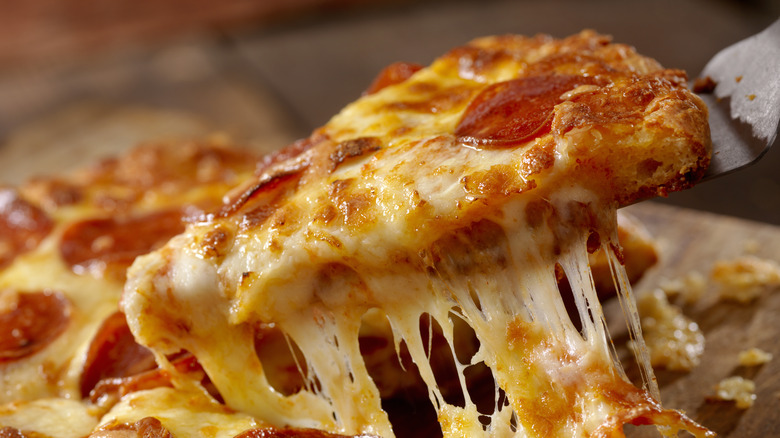
Lauripatterson/Getty Images
According to a poll taken by YouGov, roughly 64% of Americans say their favorite pizza topping is pepperoni. However, you’ll never find this popular type of pizza in Italy unless you’re dining at a tourist trap. Pepperoni itself is another American invention consisting of cured beef and pork with ingredients like paprika and peppers. Although “peperoni” is a word in Italian, it refers to bell peppers. Therefore, if you try to order a pepperoni pizza in Italy, you might get a veggie pizza.
If you’re looking for a meat pizza in Italy, typical toppings include salami or sausage. The best pizzerias in Italy use regional and seasonal ingredients like local sheep’s milk cheeses, Taggiasca olives, artichokes, and anchovies. Don’t be afraid to try different versions of this iconic dish, from classic margherita pizza in Naples to stuffed pizzolo in Sicily. You may just find that you don’t even miss those greasy, bright red discs of pepperoni.
Fettuccine Alfredo
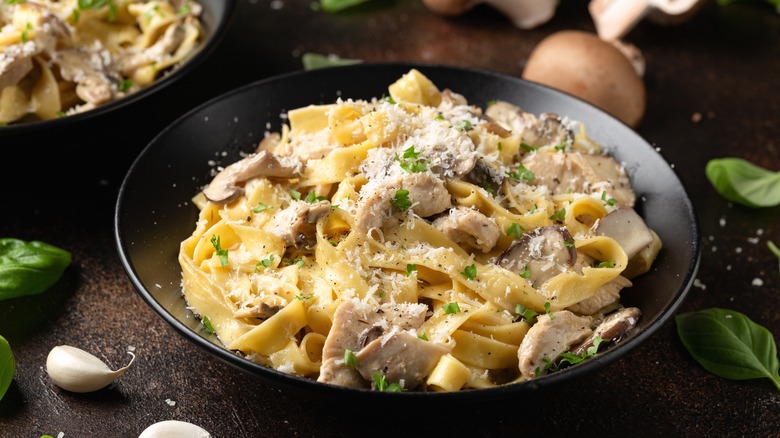
DronG/Shutterstock
While fettuccine Alfredo is a staple on many Italian restaurant menus in the U.S., the dish is not widespread in Italy. In fact, it’s really only well-known at Alfredo alla Scrofa, the restaurant in Rome where it originated. According to the restaurant’s website, chef and owner Alfredo di Lelio created the dish for his wife, who had just given birth and was feeling unwell. He created a simple yet sustenance-packed dish of fresh fettuccine noodles, butter, and parmigiana. It was an instant hit with patrons, including Hollywood celebrities Mary Pickford and Douglas Fairbanks, who spread the word about the restaurant and its delicious fettuccine Alfredo in America.
Alfredo alla Scrofa is still in business today and famous for serving its signature fettuccine Alfredo pasta. This dish is made with thin, homemade noodles twirled in butter and parmigiano cheese at your table. Don’t expect add-ons like chicken, shrimp, or broccoli. The dish is divine as it is with the eggy noodles and rich, creamy sauce. While you may be able to find copycat versions at other restaurants in Italy, nothing beats the original.
Cheese with seafood
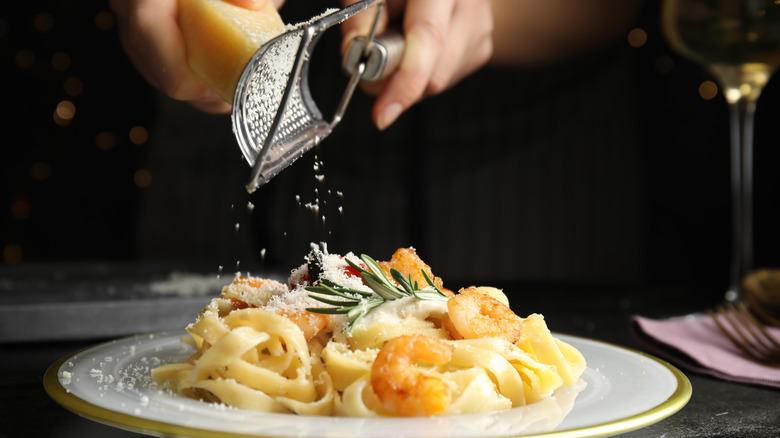
Liudmila Chernetska/Getty Images
Judging from the ubiquitous jars of grated Parmesan on tables at Italian restaurants in the States, you might believe that Italians put cheese on everything. While Italians do love their cheese, they draw the line at putting cheese on any seafood dish. The main reason for this is mainly taste. As one Quora user stated, “Italians see it as almost criminal to overpower or alter the delicate flavor of seafood. Italians revere the pure taste of the sea. Using cheese on top of seafood masks its subtle and sublime essence.”
Of course, there are a few exceptions to the rule. One is adding anchovies to pizza. There are also a few regional dishes that combine seafood and cheese. Orata alla barese is a dish from Puglia that combines sea bream, sliced potatoes, and sometimes Pecorino cheese, while Muscoli ripieni is a stuffed mussels dish from Liguria that often includes Parmigiano Reggiano. While some rules are meant to be broken, sprinkling cheese on seafood dishes is generally considered something tourists should never do in Italy because it’s regarded as bad taste.
Cioppino
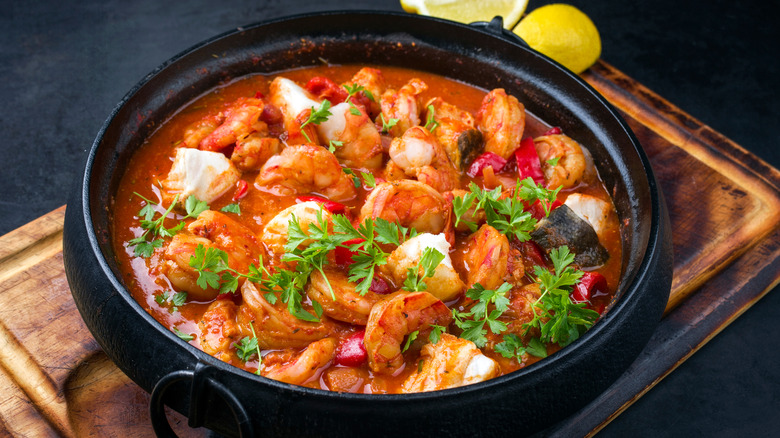
hlphoto/Shutterstock
Cioppino may have been created by Italian fishermen, but it’s technically not an Italian dish. It originated in San Francisco in the 1850s when fishermen combined leftover seafood from the day’s catches with tomatoes, garlic, wine, and spices to make a hearty soup. If you ask for cioppino in an Italian restaurant in Italy, you may be met with a blank stare — unless you’re in the Liguria region.
Some believe the name cioppino comes from “ciuppin” in the Ligurian dialect. Sources vary on its exact meaning, with some saying it means “to chop,” while others say it means “to make soup from fish.” Ciuppin is also the name of a Ligurian fish soup that may have inspired cioppino, according to L’Italo-Americano. The soup typically consists of fish, shellfish, onions, tomatoes, and wine. It may not contain West Coast delicacies like Dungeness crab, but the dish could be just what you’re looking for if you’re craving something similar to cioppino but more authentically Italian.
Lobster fra diavolo
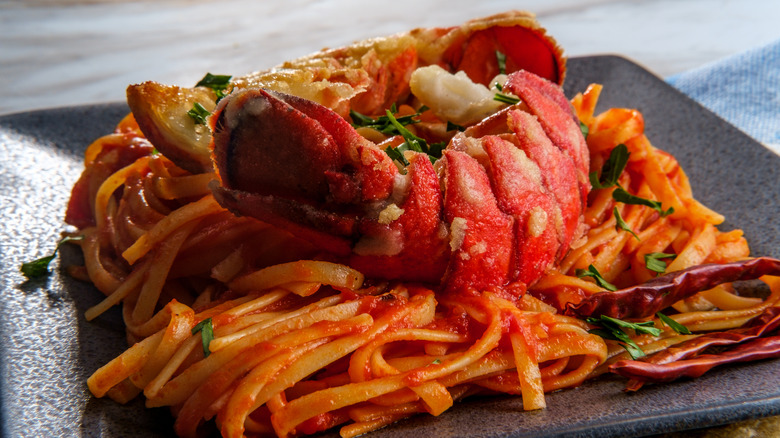
Ezume Images/Shutterstock
One of the more decadent dishes you can order at many Italian restaurants in the U.S. is lobster fra diavolo. The dish typically includes lobster doused in a spicy chili-tomato sauce and served on long-noodle pasta like spaghetti or linguine. Variations could also feature shrimp, mussels, or clams. Unfortunately, if you’re craving the devilishly hot lobster and pasta dish on your vacation to Italy, you may have to wait until you get home.
Although lobster fra diavolo has an Italian name (“fra diavolo” loosely translates to “devil brother”), it’s yet another dish that was created by Italian immigrants in the United States. While it may have originated in Naples, many chefs and cookbook authors agree that it was born in New York, as per The New York Times. That makes sense, considering the abundance of lobsters along the eastern seaboard. One authentic Italian dish that is similar and may have inspired lobster fra diavolo is pollo al diavolo. The dish comes from southern Italy and consists of chicken seasoned with cayenne pepper or chili flakes.
A latte

Artistgndphotography/Getty Images
Coffee is ingrained into Italian culture, with many people drinking numerous cups daily, either at home or in the numerous coffee bars found in nearly every town and city. If you’re a coffee lover with a penchant for lattes, there are a few phrases you should know before you visit Italy. The first is the word “latte,” which simply means milk in Italian. If you ask a barista or server for a latte in an Italian cafe, you’ll likely be served a glass of milk. The correct term for espresso with warm milk is a caffè latte or a latte macchiato.
It doesn’t end there. Italians are very particular about their coffee, so there are several slight but significant variations between coffee drinks. If you’re looking for a latte prepared the same way you like it at home, you’ll need to know the distinctions. A caffè latte typically has a base of espresso, steamed milk, and a bit of foam. A latte macchiato has a dash of espresso added to milk, making it milkier and less caffeine-forward.
Cappuccino after 11 a.m.
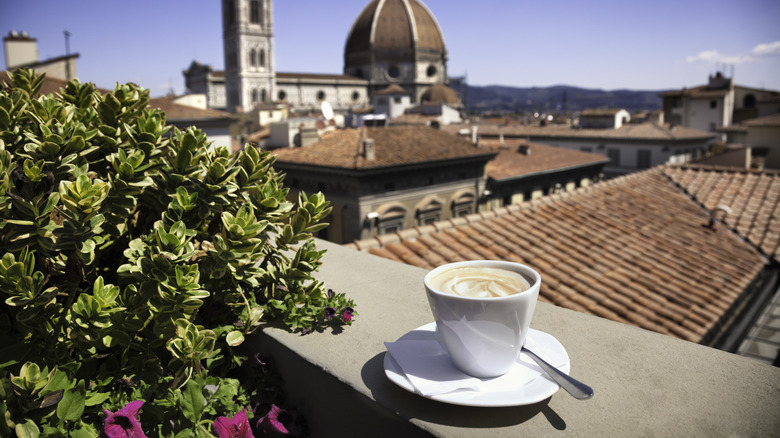
Nicolamargaret/Getty Images
Coffee lovers should also know there are set times when it is acceptable to drink certain hot drinks. For example, one embarrassing cappuccino mistake you should avoid when visiting Italy is ordering any milky espresso drink after breakfast. The rationale is that milk is bad for digestion. According to Natalie Kennedy of An American in Rome, milk is acceptable in the morning because Italian breakfasts are typically light, so the milk offsets the small meal. After a heavy meal, the milk could be too much.
The good news is that there are plenty of other caffeine-centric drinks you can enjoy later in the day without worrying about Italians looking on in disapproval. If you just need a hit of espresso, un caffè will hit the spot. If you can’t live without the milk, consider getting a caffè macchiato, which is an espresso with just a splash of milk. It’s still breaking the rule, but not as egregiously. And if you want to jazz your espresso up, a caffè corretto is espresso with a sneaky shot of grappa or liquor.
Caesar salad
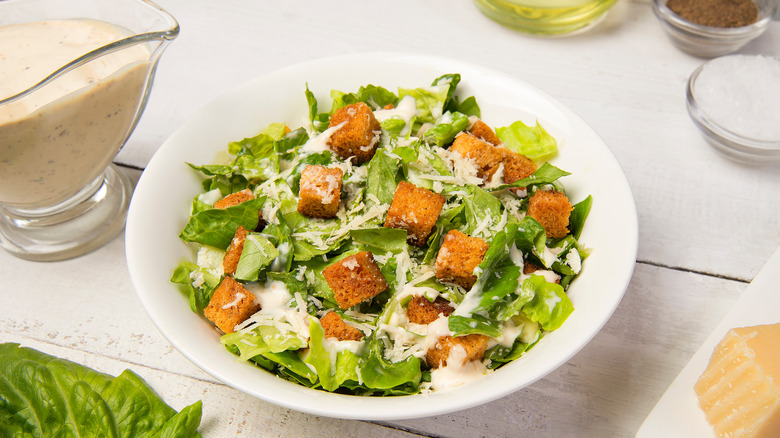
photokin/Shutterstock
The name might lead you to believe that Caesar salad is an Italian dish, but it was created in Tijuana, Mexico. The name comes from its creator, Caesar Cardini. Born in Italy, Cardini moved to California in the early 20th century and ran a restaurant in San Diego. When Prohibition hit, he moved to Tijuana to open an establishment where he could serve alcohol. Legend has it that one day, Cardini ran out of ingredients for his usual salad, so he whipped together a new version with what was on hand. The ingredients included Romaine lettuce, olive oil, lemon juice, eggs, Parmesan cheese, bread, and Worcestershire sauce.
While Caesar salad is now an iconic dish around the world, it’s not commonplace in many Italian restaurants. If you find it on a menu, it can be a glaring sign that the restaurant is a tourist trap. Authentic Italian restaurants often take seasonality into account, so the salads on offer can change depending on the time of year. For example, you might find fresh caprese salads or panzanella in the summer. Winter salads could include root or hardy vegetables like fennel and radicchio. After all, fresh ingredients beat soggy lettuce, gloopy dressing, and stale croutons any day.
Garlic bread
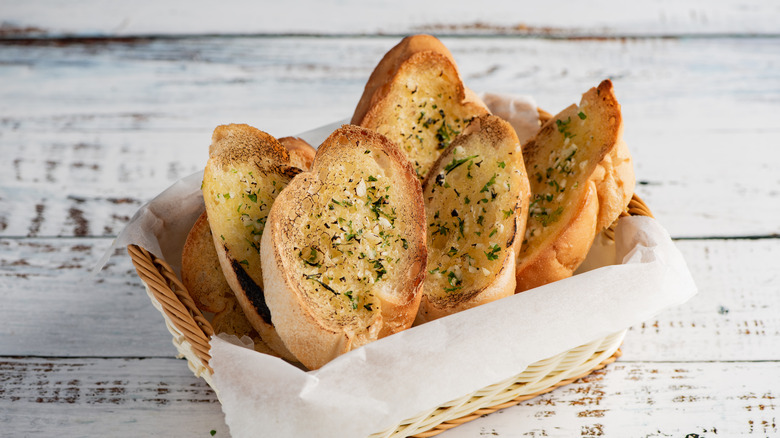
C_KAWI/Shutterstock
If there’s one popular food you can order that will make you look like a total tourist in Italy, it’s garlic bread. While bread is very much a part of Italian culinary traditions, you won’t find any crusty loaves slathered in garlic butter and broiled until crispy at restaurants in Italy serving authentic local cuisine. Garlic bread is yet another dish that was born in the New World following the Italian diaspora.
The Italian-American origins of garlic bread could have come from the southern Italian tradition of rubbing leftover bread with olive oil and garlic. There is also a Tuscan appetizer called fettunta that consists of roasted bread drizzled with olive oil, rubbed with garlic, and seasoned with salt. Italian immigrants likely brought these traditions to America and adapted the recipes to what was available, including loaves of bread or baguettes, butter, and garlic. If you’re craving garlic bread in Italy, some similar (and possibly superior) substitutes include bruschetta, focaccia, and the fettunta mentioned above.

